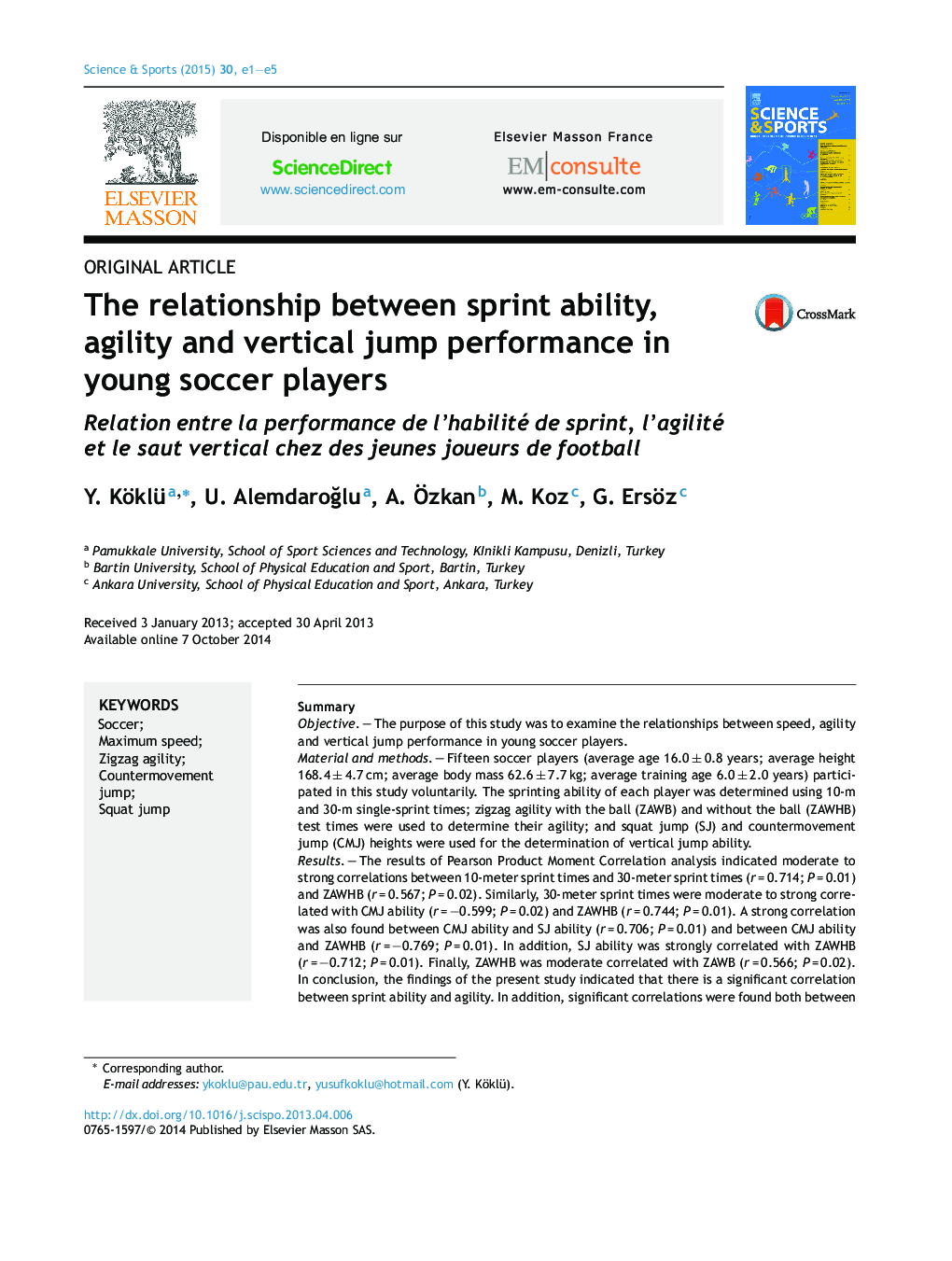| کد مقاله | کد نشریه | سال انتشار | مقاله انگلیسی | نسخه تمام متن |
|---|---|---|---|---|
| 4092684 | 1268269 | 2015 | 5 صفحه PDF | دانلود رایگان |
SummaryObjectiveThe purpose of this study was to examine the relationships between speed, agility and vertical jump performance in young soccer players.Material and methodsFifteen soccer players (average age 16.0 ± 0.8 years; average height 168.4 ± 4.7 cm; average body mass 62.6 ± 7.7 kg; average training age 6.0 ± 2.0 years) participated in this study voluntarily. The sprinting ability of each player was determined using 10-m and 30-m single-sprint times; zigzag agility with the ball (ZAWB) and without the ball (ZAWHB) test times were used to determine their agility; and squat jump (SJ) and countermovement jump (CMJ) heights were used for the determination of vertical jump ability.ResultsThe results of Pearson Product Moment Correlation analysis indicated moderate to strong correlations between 10-meter sprint times and 30-meter sprint times (r = 0.714; P = 0.01) and ZAWHB (r = 0.567; P = 0.02). Similarly, 30-meter sprint times were moderate to strong correlated with CMJ ability (r = –0.599; P = 0.02) and ZAWHB (r = 0.744; P = 0.01). A strong correlation was also found between CMJ ability and SJ ability (r = 0.706; P = 0.01) and between CMJ ability and ZAWHB (r = –0.769; P = 0.01). In addition, SJ ability was strongly correlated with ZAWHB (r = –0.712; P = 0.01). Finally, ZAWHB was moderate correlated with ZAWB (r = 0.566; P = 0.02). In conclusion, the findings of the present study indicated that there is a significant correlation between sprint ability and agility. In addition, significant correlations were found both between vertical jumping ability and sprinting ability and between vertical jumping ability and ZAWHB test performance in soccer players.ConclusionThe results of the study therefore suggest that speed, agility without the ball and vertical jumping ability share common physiological and biomechanical determinants.
RésuméObjectifL’objectif de ce travail est d’examiner la performance de la vitesse, l’agilité et le saut vertical chez de jeunes joueurs de football.Matériel et méthodesQuinze joueurs de football (âge moyen 16,0 ± 0,8 ans, taille moyenne 168,4 ± 4,7 cm, poids moyen 62,6 ± 7,7 kg, âge moyen d’entraînement 6,0 ± 2,0 ans) ont participé à cette étude volontairement. La capacité de sprint de chaque joueur a été déterminée en utilisant la durée de sprint unique de 10 m et de 30 m ; la durée du test de la capacité de zigzag (ZAWB) détermine leurs capacités (ZAWHB) avec et sans le ballon, le squat jump et le saut haut en contre-mouvement ont été utilisés pour la détermination de la capacité de saut vertical.RésultatsLes résultats de l’analyse de Pearson Product Moment Correlation ont indiqué une modérée à forte corrélation entre le temps de sprint de 10 mètres et de 30 mètres (r = 0,714 ; p = 0,01) et le ZAWHB (r = 0,567 ; p = 0,02). Une forte corrélation a été également trouvée entre le CMJ et le SJ (r = 0,706 ; p = 0,01) et entre le CMJ et le ZAWHB (r = –0,744 ; p = 0,01). En outre, la capacité de SJ était fortement corrélée avec le ZAWHB (r = –0,712 ; p = 0,01). Enfin, le ZAWHB était en corrélation modérée avec le ZAWB (r = 0,566 ; p = 0,02). En conclusion, les résultats de la présente étude ont indiqué qu’il existe une corrélation significative entre la capacité de sprint et d’agilité. En outre, les corrélations significatives ont été trouvées entre les deux capacités de saut vertical et la capacité de sprint et entre la capacité de saut vertical et la performance de test de ZAWHB chez les joueurs de football.ConclusionLes résultats d’études suggèrent que la vitesse, l’agilité sans le ballon et la capacité de saut vertical sont des déterminants physiologiques et biomécaniques.
Journal: Science & Sports - Volume 30, Issue 1, February 2015, Pages e1–e5
